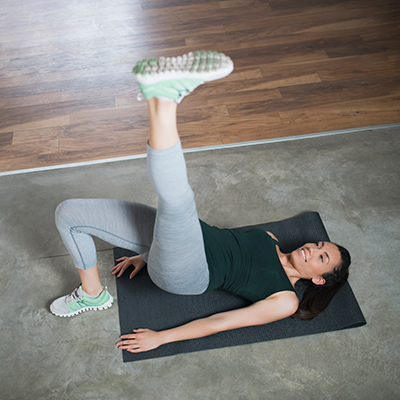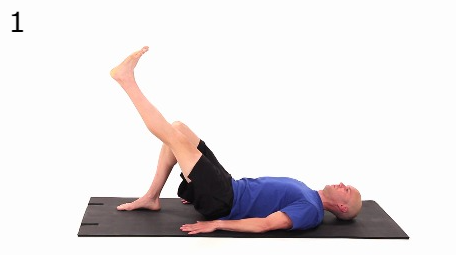8 Strengthening Exercises to Prevent Running Injuries
Posted July 04, 2023 by Greg Schimmoeller, PT, and Chris Miloscia, PT

When training for a marathon, obviously, the ultimate goal is to cross the finish line. So it’s important to take care of your body during training to achieve that goal! Here are some healthy habits that can help keep runners free from injury:
- Warm up and cool down properly.
- Watch hydration and nutrition.
- Cross train.
- Follow a training plan and be careful on advancing mileage too quickly and number of hard days.
- Alternate shoes and change every 350-400 miles.
- Address running form.
- Strengthen core, hips and foot muscles.
To help strengthen your core, hips and foot muscles, try these eight simple exercises at home:
1. Sidelying Hip Abduction
Reps: 10 / Sets: 2 / Weekly: 2-3 times each leg


- Setup: Begin lying on your side with your legs straight.
- Movement: Slowly lift your top leg up towards the ceiling, then lower it back to the starting position and repeat.
- Tip: Make sure to keep your knee straight and do not let your hips roll forward or backward during the exercise.
2. Side Plank on Elbow
Reps: 2 / Sets: 1 / Hold: 30 / Weekly: 2-3 times each side


- Setup: Begin lying on your front, propped up on your elbows.
- Movement: Engage your abdominal muscles and lift your hips up into a plank position, keeping your elbows directly under your shoulders. Hold this position.
- Tip: Make sure to keep your back straight and maintain a gentle chin tuck during the exercise.
3. Standard Plank
Reps: 2 / Sets: 1 / Hold: 30 / Weekly: 2-3 times


- Setup: Begin lying on your side with your legs straight.
- Movement: Slowly lift your top leg up towards the ceiling, then lower it back to the starting position and repeat.
- Tip: Make sure to keep your knee straight and do not let your hips roll forward or backward during the exercise.
4. Single Leg Bridge
Reps: 10 / Sets: 2 / Weekly: 2-3 times each leg


- Setup: Begin lying on your back with both knees bent and your feet resting on the floor.
- Movement: Straighten one leg, keeping it in line with your other leg. Tighten your abdominals and lift your hips off the floor into a bridge position. Then lower yourself back down and repeat.
- Tip: Make sure to keep your abdominals tight and do not let your hips rotate during the exercise.
5. Side Stepping with Resistance at Ankles
Reps: 20 steps back and forth / Sets: 2 / Weekly: 2-3 times


- Setup: Begin standing upright with a resistance band looped around your ankles. Bend your knees slightly, so you are in a mini squat position.
- Movement: Slowly step sideways, maintaining tension in the band.
- Tip: Make sure to keep your feet pointing straight forward and do not let your knees collapse inward during the exercise.
6. Walking Forward Lunge
Reps: 10 / Sets: 2 / Weekly: 2-3 times


- Setup: Begin standing upright with your hands at your hips.
- Movement: Take a large step forward, lowering into a lunge position with your knees bent at 90-degree angles. Raise yourself up and lunge forward on your other leg without letting your foot touch the ground in between.
- Tip: Make sure to keep your trunk upright during the exercise. Do not let either knee collapse inward or let your knees move forward past your toes.
7. Forward Monster Walks
Reps: 10 / Sets: 2 / Weekly: 2-3 times




- Setup: Begin in a standing upright position with a resistance band looped around your ankles.
- Movement: Slowly bend your knees into a mini squat position. Step diagonally forward with one foot, then slowly bring your feet together. Repeat in the opposite direction.
- Tip: Make sure to keep your chest upright and do not bend your knees forward past your toes.
8. Backward Monster Walks
Reps: 10 / Sets: 2 / Weekly: 7




- Setup: Begin in a standing upright position with a resistance band looped around your ankles.
- Movement: Slowly bend your knees into a mini squat position. Step diagonally backward with one foot, then slowly bring your feet together. Repeat in the opposite direction.
- Tip: Make sure to keep your chest upright and do not bend your knees forward past your toes.
Other recommended functional strengthening and plyometric exercises include:
- Body weight squats
- Lunges
- Step ups (forward, side, backwards)
- Box jumps
Want to learn more about injury prevention? To schedule an appointment with one of the running injury specialists at Summa Health Therapy Services, call 234.312.2358 or visit summahealth.org/therapy.
Greg Schimmoeller, PT
Director, Outpatient Therapy Services
Chris Miloscia, PT
Senior Physical Therapist
About the Author
Vitality eNews Sign Up
Receive the Summa Health eNewsletter for the latest health tips, advice and updates.
